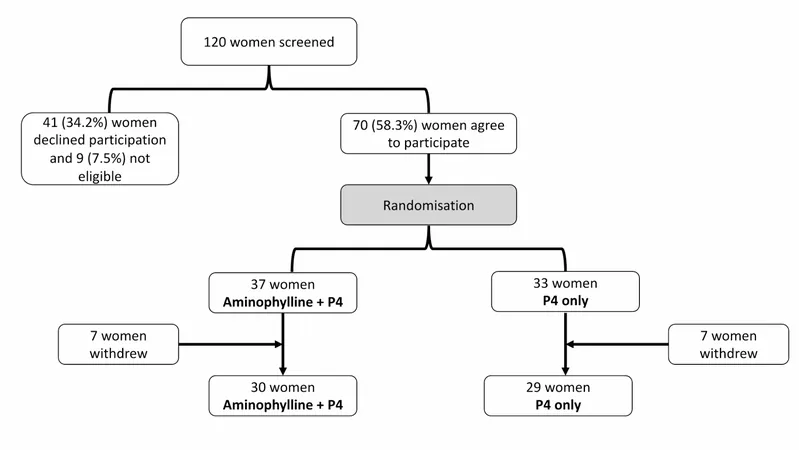
Groundbreaking Study Shows Aminophylline Might Revolutionize Preterm Labour Prevention!
2025-03-27
Author: Nur
As preterm birth rates soar worldwide—now accounting for 11% of all pregnancies—addressing this pressing public health issue has never been more crucial. With standard treatments like progesterone facing increasing scrutiny, researchers are eagerly seeking alternatives. A recent feasibility study has redefined the conversation around preterm labour prevention by exploring the potential of aminophylline, a drug with a long history in treating respiratory conditions, as a new ally for expectant mothers at high risk of spontaneous preterm labour (sPTL).
Study Overview
In an attempt to find a more effective intervention, researchers conducted an open-label randomised feasibility study evaluating the tolerability and efficacy of aminophylline combined with the standard care of progesterone in pregnant women identified as high-risk for preterm birth. The study included 70 women who met specific criteria, dividing participants into two groups: one receiving traditional progesterone treatment (33 women) and another combining progesterone with oral aminophylline (37 women).
Key Findings
The results were compelling! A staggering 91% of women in the aminophylline group tolerated the treatment without experiencing significant adverse outcomes for either mother or child. Over half of the eligible women agreed to participate, demonstrating a strong interest in exploring new options for preterm birth prevention. Notably, 67% of participants completed a post-study survey, with all reporting a willingness to consider aminophylline as a routine preventative measure for sPTL.
The study also found an impressive compliance rate of 99.42%, indicating that participants consistently followed the treatment plan. This indicates a promising path toward a larger-scale study, as the women expressed satisfaction and a willingness to accept aminophylline in future clinical applications.
Why Is This Important?
The growing body of evidence around the efficacy of aminophylline is significant, considering the disturbing trends in increased preterm births. While researchers have previously highlighted the benefits of progesterone in reducing the risk of preterm delivery, studies have raised questions about its effectiveness, particularly in high-risk populations. For instance, the OPPTIMUM trial and various meta-analyses have shown mixed results regarding the ability of progesterone to significantly lower preterm birth rates.
Aminophylline acts by increasing intracellular levels of cyclic adenosine monophosphate (cAMP), which can help maintain uterine quiescence. This study suggests that it may not only improve treatment tolerability but also potentially lower the incidence of preterm birth when used in conjunction with conventional therapies.
Implications for Future Research
Despite the promising outcomes, it is important to note that this was a feasibility study, not designed to measure actual reductions in preterm birth. However, the findings support the rationale for conducting larger randomised trials, aimed at fully exploring aminophylline's safety and efficacy as a standard treatment option alongside progesterone.
Conclusion
In conclusion, the findings from this feasibility study are a hopeful beacon for pregnant women at risk of sPTL. The positive response to aminophylline opens the door for innovative approaches to managing high-risk pregnancies. As researchers look to expand on these results, the possibility of a more effective, well-tolerated option for preventing preterm birth moves closer to fruition—potentially saving countless lives and improving neonatal outcomes on a global scale.
Stay tuned as we continue to uncover groundbreaking advancements in maternal and neonatal health!


 Brasil (PT)
Brasil (PT)
 Canada (EN)
Canada (EN)
 Chile (ES)
Chile (ES)
 Česko (CS)
Česko (CS)
 대한민국 (KO)
대한민국 (KO)
 España (ES)
España (ES)
 France (FR)
France (FR)
 Hong Kong (EN)
Hong Kong (EN)
 Italia (IT)
Italia (IT)
 日本 (JA)
日本 (JA)
 Magyarország (HU)
Magyarország (HU)
 Norge (NO)
Norge (NO)
 Polska (PL)
Polska (PL)
 Schweiz (DE)
Schweiz (DE)
 Singapore (EN)
Singapore (EN)
 Sverige (SV)
Sverige (SV)
 Suomi (FI)
Suomi (FI)
 Türkiye (TR)
Türkiye (TR)
 الإمارات العربية المتحدة (AR)
الإمارات العربية المتحدة (AR)